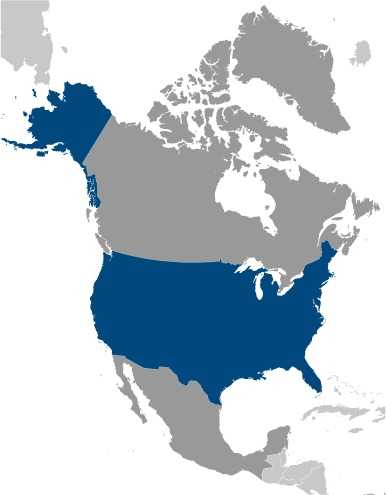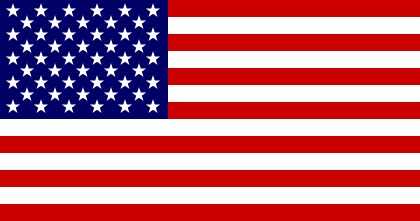Introduction
Background
Britain's American colonies broke with the mother country in 1776 and were recognized as the new nation of the United States of America after the Treaty of Paris in 1783. During the 19th and 20th centuries, 37 new states were added to the original 13 as the nation expanded across the North American continent and acquired a number of overseas possessions.
Geography
Area
total : 9,833,517 sq km
land: 9,147,593 sq km
water: 685,924 sq km
Climate
mostly temperate, but tropical in Hawaii and Florida, arctic in Alaska, semiarid in the great plains west of the Mississippi River, and arid in the Great Basin of the southwest; low winter temperatures in the northwest are ameliorated occasionally in January and February by warm chinook winds from the eastern slopes of the Rocky Mountains
Natural resources
coal, copper, lead, molybdenum, phosphates, rare earth elements, uranium, bauxite, gold, iron, mercury, nickel, potash, silver, tungsten, zinc, petroleum, natural gas, timber, arable land
People and Society
Population
total: 341,963,408
Ethnic groups
White 61.6%, Black or African American 12.4%, Asian 6%, Indigenous and Alaska native 1.1%, Native Hawaiian and Other Pacific Islander 0.2%, other 8.4%, two or more races 10.2% (2020 est.)
Languages
English only 78.2%, Spanish 13.4%, Chinese 1.1%, other 7.3% (2017 est.)
Religions
Protestant 46.5%, Roman Catholic 20.8%, Jewish 1.9%, Church of Jesus Christ 1.6%, other Christian 0.9%, Muslim 0.9%, Jehovah's Witness 0.8%, Buddhist 0.7%, Hindu 0.7%, other 1.8%, unaffiliated 22.8%, don't know/refused 0.6% (2014 est.)
Population growth rate
0.67% (2024 est.)
Government
Government type
constitutional federal republic
Capital
name: Washington, DC
Executive branch
chief of state: President Joseph R. BIDEN, Jr. (since 20 January 2021)
head of government: President Joseph R. BIDEN, Jr. (since 20 January 2021)
Legislative branch
description: bicameral Congress consists of:
Senate (100 seats; 2 members directly elected in each of the 50 state constituencies by simple majority vote except in Georgia and Louisiana which require an absolute majority vote with a second round if needed; members serve 6-year terms with one-third of membership renewed every 2 years)
House of Representatives (435 seats; members directly elected in single-seat constituencies by simple majority vote except in Georgia which requires an absolute majority vote with a second round if needed; members serve 2-year terms)
Economy
Economic overview
high-income, diversified North American economy; NATO leader; largest importer and second-largest exporter; home to leading financial exchanges; high and growing public debt; rising socioeconomic inequalities; historically low interest rates; hit by COVID-19
Real GDP (purchasing power parity)
$24.662 trillion (2023 est.)
$24.051 trillion (2022 est.)
$23.594 trillion (2021 est.)
Real GDP per capita
$73,600 (2023 est.)
$72,200 (2022 est.)
$71,100 (2021 est.)
Agricultural products
maize, soybeans, milk, wheat, sugarcane, sugar beets, chicken, potatoes, beef, pork (2022)
Industries
highly diversified, world leading, high-technology innovator, second-largest industrial output in the world; petroleum, steel, motor vehicles, aerospace, telecommunications, chemicals, electronics, food processing, consumer goods, lumber, mining
Exports
$3.052 trillion (2023 est.)
$3.018 trillion (2022 est.)
$2.567 trillion (2021 est.)
Exports - partners
Canada 16%, Mexico 15%, China 8%, Japan 4%, UK 4% (2022)
Exports - commodities
refined petroleum, crude petroleum, natural gas, cars, integrated circuits (2022)
Imports
$3.832 trillion (2023 est.)
$3.97 trillion (2022 est.)
$3.409 trillion (2021 est.)
Imports - partners
China 18%, Canada 14%, Mexico 14%, Germany 5%, Japan 4% (2022)
Imports - commodities
crude petroleum, cars, broadcasting equipment, garments, computers (2022)
Exchange rates
British pounds per US dollar: 0.811 (2022 est.), 0.727 (2021 est.), 0.780 (2020 est.), 0.783 (2019 est), 0.750 (2018 est.)
Canadian dollars per US dollar: 1.302 (2022 est.), 1.254 (2021 est.), 1.341 (2020 est.), 1.327 (2019 est.), 1.296 (2018 est.)
Chinese yuan per US dollar: 6.737 (2022 est.), 6.449 (2021 est.), 6.901 (2020 est.), 6.908 (2019 est.), 6.616 (2018 est.)
euros per US dollar: 0.950 (2022 est.), 0.845 (2021 est.), 0.876 (2020 est.), 0.893 (2019 est.), 0.847 (2018 est.)
Japanese yen per US dollar: 131.50 (2022 est.), 109.75 (2021 est.), 106.78 (2020 est.), 109.01 (2019 est.), 110.42 (2018 est.)
note 1: the following countries and territories use the US dollar officially as their legal tender: British Virgin Islands, Ecuador, El Salvador, Marshall Islands, Micronesia, Palau, Timor Leste, Turks and Caicos, and islands of the Caribbean Netherlands (Bonaire, Sint Eustatius, and Saba)
note 2: the following countries and territories use the US dollar as official legal tender alongside local currency: Bahamas, Barbados, Belize, Costa Rica, and Panama
note 3: the following countries and territories widely accept the US dollar as a dominant currency but have yet to declare it as legal tender: Bermuda, Burma, Cambodia, Cayman Islands, Honduras, Nicaragua, and Somalia
Page last updated: Wednesday, July 24, 2024




